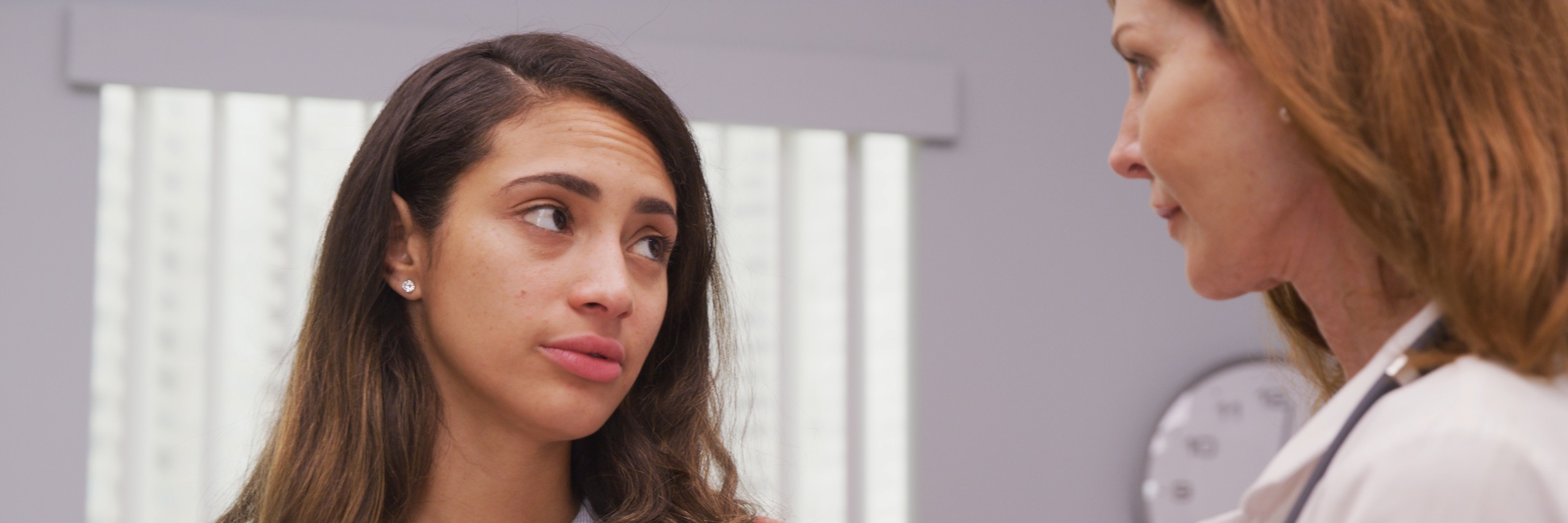Ovarian Cysts & Treatments in Chattanooga
Ovarian cysts at a glance
- Ovarian cysts are solid or fluid-filled sacs located within or on the surface of the ovaries.
- Women of any age can develop ovarian cysts, though they are most common during childbearing years.
- Ovarian cysts can result in abnormal ovulation, and according to the American Society for Reproductive Medicine ovulation dysfunction accounts for 25 percent of female infertility cases.
- Large ovarian cysts or those resulting from endometriosis or polycystic ovary syndrome (PCOS) can hamper a woman’s fertility.
- Most ovarian cysts are harmless, produce no symptoms and disappear on their own.
- Ovarian cysts can rupture. Large ovarian cysts can press against organs, both of which can result in painful symptoms.
- Treatment options include observation, hormone therapy and surgical removal.
What are ovarian cysts?
Ovarian cysts are solid or fluid-filled sacs that form on the surface or within one or both ovaries. They range in size usually between 1 – 4 centimeters but in some cases can grow quite large and measure 5 cm or more. Many women have ovarian cysts at some point in their lives, most commonly during childbearing years (19-45). The majority of ovarian cysts present minimal to no discomfort and are harmless. However certain types of ovarian cysts, or cysts that have ruptured, can produce serious symptoms.

Women have two ovaries, one located on each side of the uterus. Ovaries produce eggs during reproductive years. The ovaries produce hormones, including estrogen and progesterone that trigger the monthly menstruation cycle. Normally, every month the ovaries ovulate, meaning one of the ovaries releases an egg that makes its way down the fallopian tube, where sperm may fertilize it.
Ovulation problems account for about 25 percent of all cases of female infertility, and ovarian cysts can cause such problems.
Primary types of ovarian cysts
Functional
Functional cysts, also known as follicular cysts, are created by normal ovarian activity, or function. Typically, they also have a role in getting a woman pregnant or keeping her pregnant. For these reasons, they are called functional ovarian cysts.
They are part of the ovulation process, starting as small egg follicles. On ultrasound, egg follicles look like small dark circles in the ovary. As the egg matures, the egg follicle grows (typically to 1.8-3 cm in size) before it releases an egg. Once the egg releases, the cysts undergo changes so that it can make a hormone called progesterone. At this point, the cyst takes on a yellow color and is called a corpus luteum (see below). Unless a woman is pregnant, the corpus luteum typically lasts about 2 weeks before it regresses.
Occassionally functional cysts will linger around into the next menstrual cycle, even though they are not producing any hormones. This happens more frequently when fertility medications are used. In most cases, functional cysts go away without medical treatment and do not cause infertility.
If a woman has pain most months with ovulation, the pain may not be due to her cyst; however, it is possible her ovary has scar tissue around it and the egg follicle is growing in an enclosed space. This person may want surgery to see if the ovary is trapped and if it can be freed.
Corpus luteum
Corpus luteum cysts are common ovarian cysts. After a follicle releases an egg, it transforms into a corpus luteum structure, which produces progesterone. These cysts are usually not painful, but can cause pressure. If release of the egg causes bleeding into the cyst, it can swell to a larger size and cause pain. In rare cases, these cysts can become very large and in sometimes rupture or twist the ovary, causing painful symptoms.
Hemorrhagic
Hemorrhagic cysts are blood-filled cysts that occur when the wall of a cyst ruptures. This rupture can cause bleeding into the cyst, or corpus luteum, resulting in a hemorrhagic cyst. They can also bleed into the pelvis causing discomfort.
Cystadenomas
Cystadenoma cysts develop from cells on the surface of the ovary. These cysts are usually fluid-filled and can become very large. Cystadenomas can be asymptomatic, but often produce painful symptoms. Rarely do they resolve on their own. They are benign, and are removed by surgery.
Dermoid
Dermoid cysts develop from cells that produce human eggs (pluripotential cells, meaning they can develop into numerous different cell types). They can develop into bone, fat, hair or cartilage, among other cell types as well. When dermoid cysts occur in the ovaries, they can cause pain and/or cause the ovaries to twist, resulting in painful symptoms. They are very rarely malignant; however, women who develop dermoid cysts have a risk of them returning even after surgery.
Polycystic ovaries
A common condition that causes female infertility, polycystic ovary syndrome (PCOS) is often thought to be diagnosed by ovarian cysts; however, in reality the patient is not filled with ovarian cysts. Rather, the name describes a condition characterized by insulin resistance and ovarian dysfunction in which the patient has irregular cycles, numerous small ovary follicles (the small sacs of fluid that surround the egg, that in a normally menstruating woman would grow and ovulate each cycle) that don’t change month to month as they would in a normally menstruating female. The ultrasound appearance is of many tiny follicles, which gives the condition its name (poly, meaning many, cystic), however the tiny follicles are never so big that they would cause pain as a typical cyst would. Therefore, PCOS patients do not typically require surgery to take out these “cystic” findings, because the cystic appearing follicles are simply their egg houses/follicles. PCOS does not typically cause pain.
Endometrioid
Ovarian cysts known as endometriomas, are caused by endometriosis, a condition where cells from the endometrium (lining of the uterus) grow outside of the uterus. These can cause damage or scarring that blocks the fallopian tubes and interferes with other aspects of the pelvic region, often resulting in infertility. This condition affects women during their reproductive years endometrioid ovarian cysts are a common cause of chronic pelvic pain.
Ovarian Malignancy
Malignant ovarian tumors typically present without symptoms, but can have a wide variety of vague symptoms. On ultrasound they appear to be complex lesions, with solid and fluid components. Because they are extremely rare in our patient population, we will not discuss them further here.
Causes of ovarian cysts
- Hormonal imbalance. Functional cysts can be a result of a hormonal imbalance. A common cause of hormonal imbalances are the drugs used to help women ovulate.
- Ovarian cysts can develop due to endometriosis when tissue attaches to an ovary and forms a growth.
- Abnormal cell growth. As in any organ, cells should alternately grow and then undergo cell death and resolve. Sometimes, cell growth becomes abnormal and can cause some cells to grow too much and either develop a cyst, or can cause cells to grow abnormally and develop into cancer.
- Pelvic infections. Ovarian cysts can form due to pelvic infections that spread to the ovaries and fallopian tubes.
- Ovarian cysts can develop during the early stages of pregnancy to help support the pregnancy until the placenta forms. Rarely the cyst does not go away on its own and remains on the ovary through later stages of pregnancy, and if it becomes large and painful it may need to be surgically removed.
Symptoms of ovarian cysts
In most cases, ovarian cysts do not cause symptoms. In the occasion that symptoms occur, a woman may experience lower abdominal pain, pressure, swelling or bloating where the cyst is located. She may also experience pain during sex caused by an ovarian cyst, according to the American Society for Reproductive Medicine.
Pain may be sharp or dull and can be intermittent or constant, depending on the type and condition of the cyst. If a woman experiences severe, continuous abdominal or pelvic pain, she should seek medical attention.
Since ovarian cysts often do not show symptoms, sometimes women do not realize they have one until visiting their healthcare provider for a routine pelvic exam. As a woman ages, it is especially important to have regular pelvic exams to check for cysts. Pelvic masses diagnosed in menopause can indicate more dangerous pathology, as cancerous (malignant) cystic ovarian masses are more common in the menopausal years.
Though most cysts are symptom-free they may cause problems if they twist, bleed or rupture. A cyst that becomes large can cause the ovaries to shift from their usual position in the abdomen. This shift can increase the chance of ovarian torsion (the twisting of an ovary), which can cause severe pain and vomiting. A cyst that has ruptured causes severe pain and can lead to internal bleeding.
Ovarian cysts are often diagnosed in a pelvic exam. Physicians also may use ultrasound tests to reveal the location and size of ovarian cysts. Hormone levels may also be checked to evaluate for hormone-related causes. A pregnancy test may be done to rule out pregnancy as the cause of symptoms.
Our treatment for ovarian cysts in Chattanooga, TN
Treatments for ovarian cysts vary depending on the type of cyst, the size of the cyst and the symptoms. In many situations, doctors encourage women with ovarian cysts to keep a close eye on them and wait for their bodies to treat themselves. If no symptoms are associated with the cyst and an ultrasound shows the cyst to be harmless, medical providers will often recommend follow-up exams to ensure no changes occur.
In certain cases, hormonal medications including a birth control pill, hormone injections, hormone patches and hormone vaginal rings may be prescribed to control hormone levels. These can prevent ovulation, reducing the chances of new cyst development. Pain medications may be used to treat painful symptoms.
Medical providers may suggest the surgical removal of an ovarian cyst if it is not functional or is large and persists. Cysts that are extremely painful or causing a woman other symptoms may also be removed with surgery.
The cyst is most often removed alone. Sometimes the ovary is removed along with the cyst. Physicians may use laparoscopic (minimally invasive) surgery that involves small incisions, a video camera feed and special instruments to remove ovarian cysts.
A laparotomy may be performed if the cyst is large and might be cancerous. This involves a large incision in the abdomen and a biopsy of the removed cyst to test for cancer.
As with any surgery, these for ovarian cysts carry some risks that include blood loss, pain, damage to tissue and organs, reaction to anesthesia and scarring.
TRM expertise in treating ovarian cysts
TRM is led by founders Dr. Jessica Scotchie and Dr. Rink Murray. Both are double board certified in Reproductive Endocrinology and Infertility (REI) and Obstetrics and Gynecology (OB/GYN), as well as being members of the Society for Reproductive Endocrinology and Infertility.
Dr. Murray attended medical school at the University of Tennessee Health Science Center in Memphis, ultimately doing an REI fellowship at the University of North Carolina in Chapel Hill. He received numerous awards from patients and residents for his dedication to teaching and delivering outstanding, ethical care.
Dr. Scotchie’s specific interests include IVF, egg cryopreservation and egg donation, recurrent pregnancy loss, polycystic ovary syndrome and minimally invasive surgery. “I spend a lot of time getting to know each patient,” she says. “I want to understand their medical history of course, but just as importantly I want to understand their goals, their hesitations, their uncertainties and questions.”


